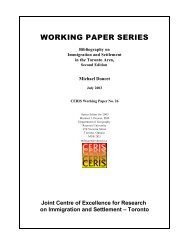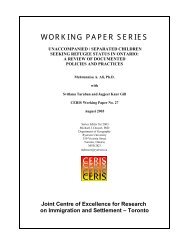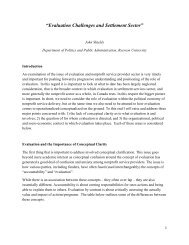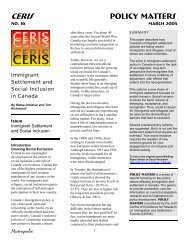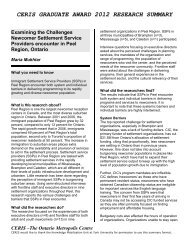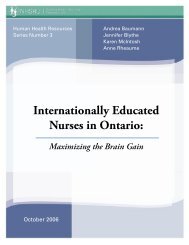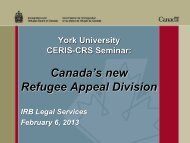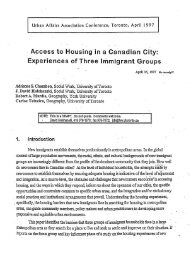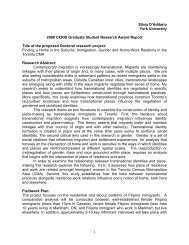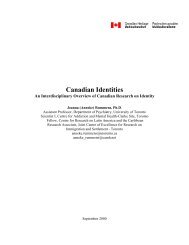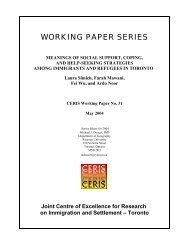EUROPEAN ORIGIN GROUPS TEND TO BE OLDERThe European ethno-racial groups tend to have fewer young people and more older people than <strong>the</strong>non-Europeans. European-orig<strong>in</strong> groups account for half <strong>the</strong> population under <strong>the</strong> age <strong>of</strong> 20, but threequarters<strong>of</strong> <strong>the</strong> population over 64. There are also dramatic age differences among <strong>the</strong> nearly 30 groups<strong>of</strong> European orig<strong>in</strong>. The English and French, along with <strong>the</strong> ethnic groups established by large-scaleimmigration before <strong>the</strong> First World War – F<strong>in</strong>ns, Estonians, Ukra<strong>in</strong>ians, and so on – have fewer youngpeople and many more elderly. For <strong>the</strong>se groups, only about 5 percent are under 15 years <strong>of</strong> age,compared to <strong>the</strong> population average <strong>of</strong> 18.0 percent. These figures probably result from relatively lowfertility, but <strong>the</strong> dramatically larger number <strong>of</strong> older people <strong>in</strong> <strong>the</strong>se groups must also reflect <strong>the</strong> tendency<strong>of</strong> <strong>the</strong>ir children to report a different ethno-racial membership than <strong>the</strong>ir parents. Perhaps <strong>the</strong>y th<strong>in</strong>k <strong>of</strong><strong>the</strong>mselves as “Canadian” or perhaps <strong>the</strong>ir parents were <strong>of</strong>ten from two different ethno-racial groups, so<strong>the</strong>ir children report more than one ancestry <strong>in</strong> <strong>the</strong> Census.The Polish, Romanian and Russian groups, presumably because <strong>the</strong>ir numbers are supplemented bypost-Soviet immigration, have younger populations with an age distribution similar to <strong>the</strong> <strong>City</strong> average.The Portuguese community, on <strong>the</strong> o<strong>the</strong>r hand, has a high proportion <strong>of</strong> young people, 18.8 percent,under 15, and relatively few members, 8.1 percent, 65 or older.A number <strong>of</strong> <strong>the</strong> Sou<strong>the</strong>rn European ethno-racial groups have much higher proportions <strong>of</strong> peoplebetween 45 and 64 than over 64, suggest<strong>in</strong>g a large, com<strong>in</strong>g <strong>in</strong>crease <strong>in</strong> <strong>the</strong> proportion <strong>of</strong> elderly. Amongall Europeans, 24.8 percent are 45-64 and 17.5 percent are 65 and older. For Greeks, <strong>the</strong> correspond<strong>in</strong>gproportions are 30.5 and 11.5 percent; for Croatians, 31.8 and 12.5 percent, and for Maltese 5.7 and 12.8percent, and for <strong>the</strong> Portuguese 21.9 and 8.1 percent.NON-EUROPEAN COMMUNITIES, EXCEPT FOR EAST AND SOUTHEAST ASIANS, ARE YOUNGERTable 1 shows that Aborig<strong>in</strong>al people and <strong>Toronto</strong>nians <strong>of</strong> Black, African and Caribbean orig<strong>in</strong>,South Asians, Arab and West Asian groups and Lat<strong>in</strong> Americans – all <strong>the</strong> non-Europeans except <strong>the</strong> Eastand Sou<strong>the</strong>ast Asians – have younger than average age pr<strong>of</strong>iles. In some <strong>of</strong> <strong>the</strong> regional groups, <strong>the</strong>averages conceal a great deal <strong>of</strong> variation, primarily <strong>in</strong> <strong>the</strong> balance among very young people, youngadults, and middle-aged adults, as <strong>the</strong> proportions over <strong>the</strong> age <strong>of</strong> 64 are low and relatively uniform. Forexample, <strong>the</strong>re are many more young children <strong>in</strong> <strong>the</strong> “African and Black” group, 44.1 percent under <strong>the</strong>age <strong>of</strong> 15, than among Jamaicans, with only 26.8 percent under 15; and 42.8 percent <strong>of</strong> Ghanaians areunder 15, compared to 22.3 percent <strong>of</strong> Ethiopians.<strong>Ethno</strong>-<strong>Racial</strong> <strong>Inequality</strong> <strong>in</strong> <strong>Toronto</strong>: <strong>An</strong>alysis <strong>of</strong> <strong>the</strong> 1996 Census 19
In part, <strong>the</strong>se differences <strong>in</strong> <strong>the</strong> age distributions must reflect <strong>the</strong> way that people choose to fill out<strong>the</strong> Census questionnaire. Perhaps parents who have immigrated from Caribbean nations and whose ownidentity is “national” (Jamaican, Barbadian, etc.) tend to describe <strong>the</strong>ir children, especially if <strong>the</strong>y areborn <strong>in</strong> Canada, as “Black”. At <strong>the</strong> same time, to <strong>the</strong> extent that parents have different ancestries andreport <strong>the</strong>ir children as shar<strong>in</strong>g both <strong>the</strong>ir heritage, we should f<strong>in</strong>d that multiple-orig<strong>in</strong> groups tend to beyounger. Thus <strong>the</strong> table shows that about 18.5 percent <strong>of</strong> <strong>the</strong> people whose heritage is entirely Aborig<strong>in</strong>alor Aborig<strong>in</strong>al and English or French are under <strong>the</strong> age <strong>of</strong> 15, compared to 31.9 percent <strong>of</strong> people who areAborig<strong>in</strong>al and also report ano<strong>the</strong>r orig<strong>in</strong> besides French and English. This suggests an <strong>in</strong>creas<strong>in</strong>gtendency towards marriage between Aborig<strong>in</strong>als and non-Aborig<strong>in</strong>als outside <strong>the</strong> <strong>An</strong>glo and French“charter” groups.The Arab and West Asian groups exhibit a number <strong>of</strong> different demographic patterns: <strong>the</strong> Afghanpopulation is <strong>the</strong> youngest, with over one third are under 15; <strong>the</strong> “West Asian and European” group issimilar to <strong>the</strong> European pr<strong>of</strong>ile; and <strong>the</strong> Armenians, whose experience is quite different from <strong>the</strong> o<strong>the</strong>rs <strong>in</strong>this regional group<strong>in</strong>g, is <strong>the</strong> oldest group, with only 16.0 percent under <strong>of</strong> 15 and 15.5 percent <strong>of</strong> itsmembers 65 and older. All <strong>the</strong> o<strong>the</strong>r groups, Egyptians, Iranians, Lebanese, Turks, “O<strong>the</strong>r Arabs andWest Asians” and <strong>the</strong> “Multiple Arab and West Asian” group are quite similar, with an age distributionsomewhat younger than average.EAST AND SOUTHEAST ASIANSThe age structure <strong>of</strong> <strong>the</strong> comb<strong>in</strong>ation <strong>of</strong> East and Sou<strong>the</strong>ast Asians and Pacific Islanders is close to<strong>the</strong> general population, though a bit younger. The proportions between 65 and 74 and over 75 are 6.1 and3.1 percent, respectively, compared to 8.0 and 4.8 percent for <strong>the</strong> <strong>Toronto</strong> population. This similarityreflects ma<strong>in</strong>ly <strong>the</strong> numerical predom<strong>in</strong>ance <strong>of</strong> <strong>the</strong> Ch<strong>in</strong>ese, who account for about 60 percent <strong>of</strong> <strong>the</strong> Eastand Sou<strong>the</strong>ast Asians, and whose age structure is very close to <strong>the</strong> population average. The Vietnamesetend to be younger, 27.1 percent are under 15 and <strong>the</strong> Japanese older, only 7.3 percent are under 15.IMPLICATIONS FOR SOCIAL POLICYTwo general arguments about social policy follow from this evidence. First, to <strong>the</strong> extent that car<strong>in</strong>gfor young children requires resources, groups vary significantly <strong>in</strong> <strong>the</strong> demands placed upon <strong>the</strong>m.Remember that s<strong>in</strong>ce <strong>the</strong> total <strong>of</strong> all <strong>the</strong> age groups must equal one hundred percent, groups with moreyoung people generally have fewer adults to care for <strong>the</strong>m – especially if <strong>the</strong> percentage <strong>of</strong> elderly is stillquite small.<strong>Ethno</strong>-<strong>Racial</strong> <strong>Inequality</strong> <strong>in</strong> <strong>Toronto</strong>: <strong>An</strong>alysis <strong>of</strong> <strong>the</strong> 1996 Census 20
- Page 6 and 7: origin, South Asians, Arab and West
- Page 8 and 9: Table of ContentsExecutive Summary.
- Page 10 and 11: IntroductionThis Report provides de
- Page 12 and 13: Methodological NotesThis Report pro
- Page 14 and 15: Chapter 1Defining Ethno-Racial Grou
- Page 16 and 17: question, described above. The “C
- Page 18 and 19: “Barbadians.” Likewise, people
- Page 20 and 21: acial identification question, redu
- Page 22 and 23: Table 1, continuedEthno-Racial Grou
- Page 24 and 25: percentage of a group has the need.
- Page 26 and 27: ARAB AND WEST ASIAN ORIGINSApproxim
- Page 30 and 31: The key question involves the numbe
- Page 32 and 33: Table 2, continuedPercentage and Nu
- Page 34 and 35: A second policy concern involves th
- Page 36 and 37: NON-NATIONAL, “RACIAL” AND MULT
- Page 38 and 39: Table 3, continuedKnowledge of Engl
- Page 40 and 41: majority of people speak English. T
- Page 42 and 43: Fully 96.1 percent of Torontonians
- Page 44 and 45: Chapter 2EducationIf educational cr
- Page 46 and 47: Table 4, continuedHighest Level of
- Page 48 and 49: Ethno-Racial Inequality in Toronto:
- Page 50 and 51: Educational Attainment of AdultsAbo
- Page 52 and 53: EUROPEAN ORIGINAmong Europeans, edu
- Page 54 and 55: GROUPS WITH HIGHER PROPORTIONS OF N
- Page 56 and 57: Table 5, continuedSchool Attendance
- Page 58 and 59: Ethno-Racial Inequality in Toronto:
- Page 60 and 61: Of most concern are the small numbe
- Page 62 and 63: Not counted as unemployed are “di
- Page 64 and 65: Table 6, continuedLabour Force Char
- Page 66 and 67: Ethno-Racial Inequality in Toronto:
- Page 68 and 69: percent for the African, Black and
- Page 70 and 71: LATIN AMERICAN ORIGINSThe two Latin
- Page 72 and 73: Table 7, continuedIncome from Emplo
- Page 74 and 75: efore coming to Canada likely refle
- Page 76 and 77: Table 8a, continuedOccupations of W
- Page 78 and 79:
Table 8bOccupations of Men by Ethno
- Page 80 and 81:
Table 8b, continuedOccupations of M
- Page 82 and 83:
Ethno-Racial Inequality in Toronto:
- Page 84 and 85:
eing an employee; just 3.2 percent
- Page 86 and 87:
Table 9, continuedIncidence of Self
- Page 88 and 89:
AFRICAN, BLACK AND CARIBBEAN ORIGIN
- Page 90 and 91:
esult in similar levels of income.
- Page 92 and 93:
Among the individual ethno-racial g
- Page 94 and 95:
Chapter 4Poverty and Individual and
- Page 96 and 97:
Introduction to the TablesThe first
- Page 98 and 99:
Table 10, continuedIncidence of Pov
- Page 100 and 101:
Ethno-Racial Inequality in Toronto:
- Page 102 and 103:
Table 11, continuedIncidence of Chi
- Page 104 and 105:
Ethno-Racial Inequality in Toronto:
- Page 106 and 107:
types of families are not an intuit
- Page 108 and 109:
children and 12.8 percent of Arab/W
- Page 110 and 111:
Table 12, continuedIncidence of Pov
- Page 112 and 113:
Southeast Asians and Pacific Island
- Page 114 and 115:
Table 13, continuedMedian Family In
- Page 116 and 117:
Ethno-Racial Inequality in Toronto:
- Page 118 and 119:
Table 14, continuedMedian Individua
- Page 120 and 121:
Ethno-Racial Inequality in Toronto:
- Page 122 and 123:
SOUTH ASIAN ORIGINSWhile just over
- Page 124 and 125:
LATIN AMERICAN ORIGINSDue to statis
- Page 126 and 127:
There are remarkable ethno-racial d
- Page 128 and 129:
Table 15, continuedHome Ownership o
- Page 130 and 131:
percent of Italian families own the
- Page 132 and 133:
The most severe disadvantage affect
- Page 134 and 135:
Men in Lower SkillJobs(Table 8b/Cha
- Page 136 and 137:
which included all other African na
- Page 138 and 139:
In Lower Skill Non-Manual Occupatio
- Page 140 and 141:
skilled non-manual occupations in 1
- Page 142:
segregation, the effects of unequal



